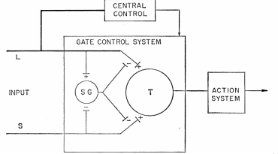Welcome to the first CNAP round-table meeting, which will take place on Thursday 1 December 2016, at 13.00 - 15.00.
This first round-table topic discussion will be on the “Gate-Control Theory” and we will focus on key papers in addition to relevant theoretical concepts and papers. For this meeting, the original and contemporary “Gate-Control Theory” will be presented, followed by presentations of selected papers given by engaged CNAP members (you).
Program
13.00
Welcome/short introduction to the CNAP round-table topic discussions by Thomas
Presentation of selected papers
- “Pain Mechanisms: A New Theory“ by Maria (5 min)
- “Gain Control Mechanisms in the Nociceptive System” by Rosa (10 min)
- Questions (5 min)
13.25
Pitch of all incoming papers (1 min for each paper/participant)
Why choosing this particular paper?
13.45
Presentation of selected papers (each presentation 10 + 5 min)
- “A Mathematical Model of the Gate Control Theory of Pain” by Eric
- “In Vino Interrogation of Spinal Mechanosensory Circuits” by Daniele
- “Pain relief by touch: A quantitative approach” by Steffen
14.30
Round-table discussion

Incoming papers:
- Sensorimotor training and cortical reorganization
- The Role of the Dorsal Root Ganglion in Cervical Radicular Pain: Diagnosis, Pathophysiology, and Rationale for Treatment
- Brain electrical correlates of pain processing
- Review of aetiological concepts of temporomandibular pain disorders: towards a biopsychosocial model for integration of physical disorder factors with psychological and psychosocial illness impact factors
- Targeting Chronic Recurrent Low Back Pain From the Top-down and the Bottom-up: A Combined Transcranial Direct Current Stimulation and Peripheral Electrical Stimulation Intervention
- Analysis of hyperalgesia time courses in humans after painful electrical high-frequency stimulation identifies a possible transition from early to late LTP-like pain plasticity
- A Mathematical Model of the Gate Control Theory of Pain (selected for presentation)
- In Vivo Interrogation of Spinal Mechanosensory Circuits (selected for presentation)
- A feed-forward spinal cord glycinergic neural circuit gates mechanical allodynia
- A long noncoding RNA contributes to neuropathic pain by silencing Kcna2 in primary afferent neurons
- Pain
- Targeted Ablation, Silencing, and Activation Establish Glycinergic Dorsal Horn Neurons as Key Components of a Spinal Gate for Pain and Itch
- Pain Facilitation and Activity-Dependent Plasticity in PainModulatory Circuitry: Role of BDNF-TrkB Signaling and NMDA Receptors
- Excitatory and modulatory effects of inflammatory cytokines and neurotrophins on mechanosensitive group IV muscle afferents in the rat
- Pain relief by touch: A quantitative approach (selected for presentation)
- Diffuse noxious inhibitory controls (DNIC). II. Lack of effect on nonconvergent neurones, supraspinal involvement and...
